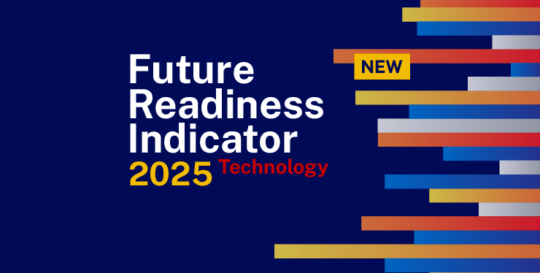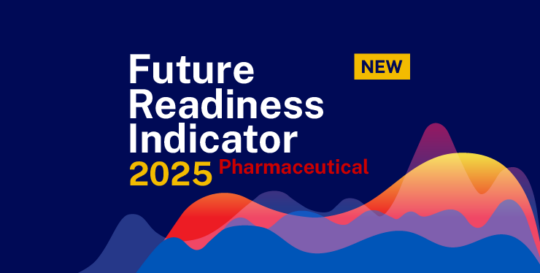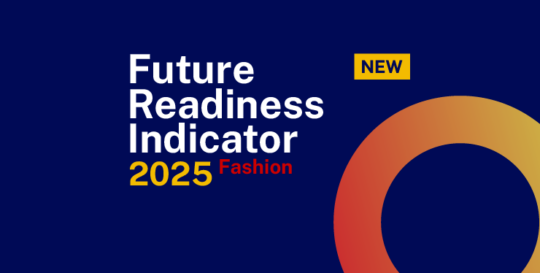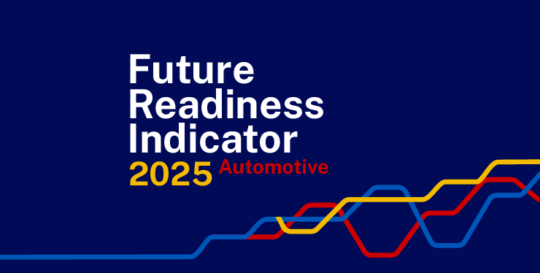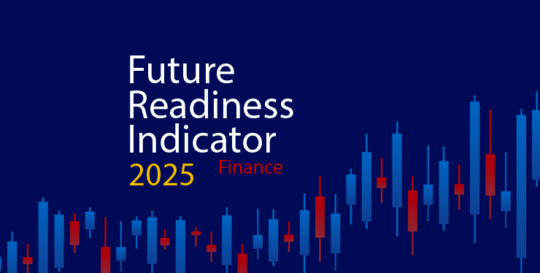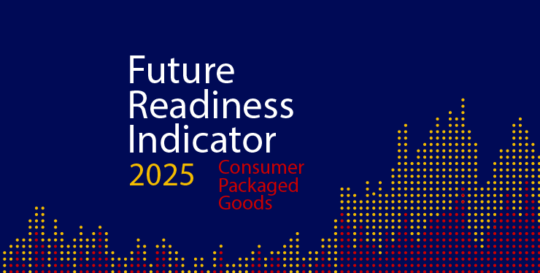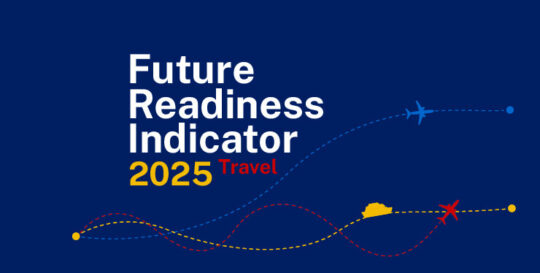IMD business school for management and leadership courses



Technology, Pharmaceutical, Fashion Brands
Released on 25 November 2025
Future Readiness Indicator 2025
Technology, Pharmaceutical, Fashion Brands
Released on 25 November 2025
How future-ready companies keep winning when AI shocks and geopolitics upend the game.
- Tech giants Nvidia, Microsoft, Alphabet, and Meta dominate the technology sector not because they spend the most on AI, but because they control the entire AI stack from silicon to the user interface.
- Johnson & Johnson, Roche, and AstraZeneca are pharma’s most future-ready companies. Their broad diversification, combined with massive R&D spend and early AI adoption, sets them apart.
- Fashion platform powerhouses LVMH, Inditex, and Hermès are the top-ranking fashion brands. With unmatched brand equity, supply chain expertise, and deep cash reserves, they remain ahead of the pack.
Lausanne, Switzerland, 25 November 2025: The ability to execute across entire ecosystems now determines which companies will lead in an era of rapid geopolitical shifts and artificial intelligence disruption.
“We’re seeing a divergence play out,” said Howard Yu, Director of the IMD Center for Future Readiness. “Companies that pin everything on one blockbuster are getting crushed. The ones that spread their bets across entire ecosystems aren’t just absorbing the shocks; they’re turning volatility into an advantage. The question every CEO should ask is simple: if my core market vanished tomorrow, would the company still stand? For most mid-market companies, the answer is no. That’s the story behind this year’s indicator.”
The 2025 Future Readiness Indicator measures how 49 technology companies, 27 pharmaceutical companies, and 41 fashion companies stack up against a new reality of turbulent economic policies, increased innovation, tightening regulations, and heightened consumer expectations.
Future readiness by sector
The Future Readiness Indicator finds that customer-centric companies with diversified offerings that demonstrate supply chain agility, regulatory adaptability, and use AI to deliver real business value are the most future-ready.
Technology
Masters of the AI stack dominate amidst a US–China tech decoupling

The Future Readiness Indicator 2025 highlights a global tech landscape in flux. The competitive edge belongs to those that are able to control every layer of the AI ecosystem – chips, cloud infrastructure, and the user interface, while legacy hardware companies fall behind.
- US companies – Nvidia (100.0), Microsoft (97.4), Alphabet (94.1), and Meta (91.4) – continue to dominate. Their competitive edge comes from mastery of the entire AI stack (infrastructure, software, and data), their financial strength, and their ability to shift their capabilities from within at the speed necessary to stay ahead.
- Some of the world’s most recognizable brands and regional powerhouses form the mid-tier (ranks 5–19), including consumer-tech icons Apple and Amazon, chip leaders Samsung Electronics and TSMC, and enterprise specialist IBM. These firms excel in distinct domains but lag behind the top-tier companies either in innovation velocity or ecosystem reach.
- Chinese tech companies (Tencent, Alibaba, Baidu, and JD.com) have slipped amid sanctions (limiting their access to much-needed AI hardware), tighter regulation, and a slower domestic economy. However, it would be premature to count China out; its companies command vast troves of user data and benefit from rapid, mass-market adoption.
- Alphabet climbed to third position (improving its score from 80.7 in 2024 to 94.1), overtaking Meta (91.4). Meta exemplifies the trap: $70-72bn in 2025 CapEx while Reality Labs loses $5.18bn annually and AI monetization lags infrastructure costs by 2:1. Meanwhile, Alphabet’s disciplined AI execution, investing $80bn whiles keeping margins above 30%, has made it the investor favorite. The lesson is stark: capital intensity without revenue connection is a wealth destroyer, not an innovation engine.
- Samsung transformed itself from a lagging supplier to a central player in the AI boom. It has experienced a meteoric rise from 20th place to seventh. Its persistence with its latest high-bandwidth memory chips paid off when, after several failed attempts, it passed Nvidia’s tough qualification tests.
- Companies that remain tethered to legacy hardware are finding it harder to adapt to the AI-centric world.
Pharmaceutical
From an industry of products to an industry of solutions

The Future Readiness Indicator 2025 reveals a pharmaceutical industry undergoing rapid transformation. The competitive edge now belongs to companies that control a diverse portfolio of therapeutic platforms, from obesity drugs (GLP-1s) and antibody-drug conjugates (ADCs) to cell and gene therapies. The most future-ready companies are pairing therapies with devices, apps, and data services to improve outcomes and deepen engagement. Meanwhile, legacy giants, clinging to the old pill-only model and weighed down by patent expirations, struggle to keep up.
- Johnson & Johnson (100.0), Roche (97.2), and AstraZeneca (95.4) are pharma’s most future-ready companies, according to the 2025 Future Readiness Indicator. Their edge lies in broad diversification, spanning traditional drugs, biologics, and medical devices, combined with massive R&D spending and early AI adoption. By integrating digital health and data analytics across their value chains, these companies continue to outpace peers in both innovation and growth.
- A wide middle band (ranks 4–16) includes major players like Novartis, Eli Lilly, Merck & Co., Pfizer, Sanofi, and GSK. These companies excel in select domains or because of their blockbuster pipelines. However, they lag the elite group in innovation velocity, portfolio breadth, or ecosystem reach. Many are actively restructuring or pursuing biotech acquisitions and spinoffs to accelerate transformation and close the gap.
- Novo Nordisk, one of Europe’s most valuable companies, drops to 12th place in this year’s indicator, signaling risk. It remains highly concentrated, deriving most of its revenue from diabetes and obesity care. This single-track model offers huge upside, but also vulnerability to competitors (like Eli Lilly) catching up and supply chain constraints.
- Generic-drug manufacturers, old-line conglomerates, and smaller niche specialists are being left behind due to patent expirations eroding pricing power, cost pressures squeezing margins, and limited investment in data, digital, or next-generation science.
Fashion
The great divide: Platform dominance, sportswear turmoil, and the collapse of the legacy model

The top of the 2025 Future Readiness Indicator ranking is dominated by models of platform-based resilience, while companies that have been slow to adapt and remain culturally relevant fail to resonate with the modern consumer.
- As 15,000 retail stores shut their doors in 2025 – double that of last year – the map of global fashion is splitting in two. In this environment only the extremes are surviving: at one end, ultra-luxury heritage, whilst at the other end, lightning-fast trend machines. Everything in the middle is disappearing; Macy’s, Swatch and Under Armour.
- At the top of the industry, the diversified luxury super-conglomerate LVMH (100.0) takes the top spot. Its portfolio of timeless houses has become an almost unbeatable buffer against market shocks. Close behind is Inditex (91.4), the vertically integrated, data-driven ecosystem behind Zara, Massimo Dutti and Bershka. Hermès (87.2) follows, proving that disciplined scarcity and supply-chain mastery still scale. What unites these leaders is simple: unshakeable brand equity, end-to-end operational control, and cash reserves deep enough to ride out any storm.
- A wide mid-tier band (ranks 4–13) is populated by sportswear giants and other multi-brand players. Nike, Adidas, Lululemon, Fast Retailing (Uniqlo), and Kering (Gucci, YSL, Balenciaga) all score well in select areas. These include Nike’s digital direct-to-consumer ecosystem, Lululemon’s community-driven brand fervor, and Fast Retailing’s global reach.
- After a rocky 2023 (its first net loss in decades), Adidas has rebounded under new CEO Bjørn Gulden through reigniting iconic brands and clearing excess inventory. It rises from 10th place to 4th in this year’s indicator.
- Off-price distributors and legacy brands, including Macy’s, Ross Stores, and Burlington, are being left behind because of innovation stagnation, high debt burdens, or narrowly focused brands that limit their prospects.
REPORT Future Readiness Indicator report: Built for shocks: The companies that keep winning when the game changes
The Future Readiness Indicator report: Built for shocks: The companies that keep winning when the game changes, takes a deep dive into the data and showcases how technology, pharmaceutical, and fashion companies have performed in this year’s indicator. The report, available on the homepage, looks at the forces transforming these sectors in 2025 and offers insights into what companies can do to prepare. It also takes an in-depth look at which companies are leading the pack and those that are falling behind.
